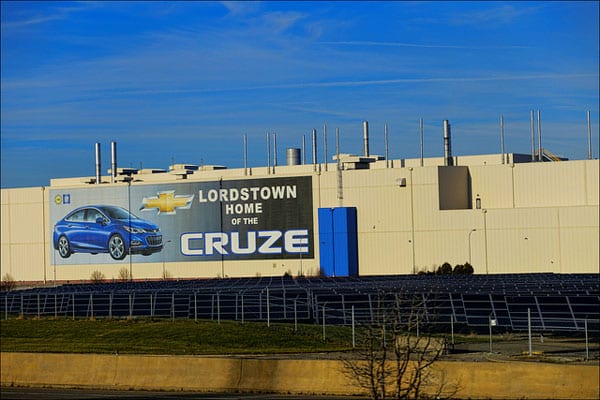
March 13, 2019; The Vindicator (Youngstown, OH)
Located on 965 acres of land, adjacent to the Ohio turnpike, roughly halfway between Cleveland and Pittsburgh, the General Motors (GM) Lordstown factory produced cars for 53 years—but no more. During that time, workers assembled an estimated 16.5 million cars and vans. The last car, a Chevrolet Cruze, rolled off the line a week ago Wednesday.
When the Lordstown facility opened, it employed 6,000 workers; at its peak, in the mid-1970s, 12,000 worked at the facility. This year, there were only 1,400 remaining production workers and 1,600 workers total to lay off. Of these workers, 400 are transferring to other cities, 350 are retiring, while the rest are looking for other work. Wages for line workers at the plant ranged from $61,000 to $88,000, compared to an average wage in the Youngstown area of $38,000.
While only 1,600 are being laid off now, that number is deceptively low, as layoffs occurred in three stages. Between January 2017 and the plant’s final closure this month, over 4,300 lost their jobs. As Stan Boney of local television station WKBN reports, a study authored by professors Iryna Lendel and Merissa Piazza, and graduate research assistant Matthew Ellerbock of Cleveland State University, puts the “cumulative job loss at 7,711 or 4.4 percent of all the jobs in Mahoning and Trumbull counties.” The reason the number is 7,711, Boney explains, is that, according to the study, “For every four jobs lost at GM, two were lost in supply chain companies and one was lost in the consumer services sector.” The study estimates the overall cost of the plant’s closing to the local economy at $1.6 billion or 9.4 percent of the gross regional product and will cost local government $12 million in revenue.
Writing in the Vindicator, David Skolnick notes that Ohio Governor Mike DeWine has said that he’s been given no indication from GM what the future of the facility will be. DeWine said that, “My focus is to do everything to get jobs back in that plant, understanding that our hands are really tied until there is some movement from General Motors.” DeWine is hoping to know more from GM “in four to six weeks.”
Sign up for our free newsletters
Subscribe to NPQ's newsletters to have our top stories delivered directly to your inbox.
By signing up, you agree to our privacy policy and terms of use, and to receive messages from NPQ and our partners.
Often when layoffs at manufacturing plants occur, the story told centers on supposedly inevitable “market forces,” but as Michael Shields of the nonprofit advocacy group Policy Matters Ohio explains, better policy could have led to better outcomes. A four-page policy brief from the group notes that,
Better Federal policies might have prevented Lordstown’s closure. A substantial gas tax would reduce carbon waste and could be used to smooth fuel prices to make them more predictable. Today, automakers face a high stakes gamble in predicting future fuel prices. Last week the Chevy Cruze fell victim to dwindling consumer demand from low fuel prices: a decade ago GM shut down the Moraine truck and SUV plant, again citing low consumer demand, that time due to high fuel prices.
Other measures mentioned by Shields include:
- Extend the Art Modell Law to other businesses. “Ohio’s Art Modell law,” notes Shields “requires professional sports teams to give at least six months’ notice of intent to leave, and give locals the opportunity to buy the franchise.” It so happens that the Ohio Employee Ownership Center—founded in 1987 by the late John Logue, a former Kent State professor who saw employee ownership as an alternative to plant shutdowns—has in the past three decades helped preserve over 20,000 jobs statewide by converting business to employee ownership.
- Strengthen state WARN Act protections and enforcement. Ohio, Shields explains, follows the federal Worker Adjustment and Retraining Notification (WARN) Act, which requires employers of 50 or more workers to give 60 days’ notice before layoffs. “Some states,” note Shields, “include smaller firms and layoffs and provide severance pay.”
- Get smart about tax incentives. Ohio allocated $82 million to GM in 2006 on the promise the plant would stay open at least 30 years. Obviously, GM has reneged on that commitment.
Such policies (and others), Shields contends, can make a difference by reducing the number of layoffs and mitigating their impact when they occur. The policy brief concludes, “Responsible public policy must support the displaced workers, and take steps to reduce the incidence of events like this happening again.”—Steve Dubb











